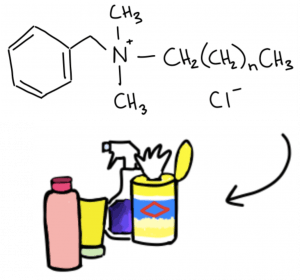PhD student Olivia Barber reviewed what happens to benzalkonium chloride when it gets into the environment and what potential consequences it can have on biological organisms, including microbes. She reflected on the experience, which started with a class paper, here.
When we first got the assignment to write about an emerging organic contaminant in Dr Hartmann’s class, I decided to write about benzalknoium chloride, a chemical widely used in disinfectants and consumer products. I enjoyed the informal and creative spin that Dr Hartmann encouraged us to put on our writing. After the quarter finished, Dr Hartmann reached out to me and suggested we turn the paper into a publication. Because of the timeliness of the topic, she recommended we write both an op-ed and peer-reviewed review paper. Both types of writing have specific styles, so Dr Hartmann focused on the op-ed, which she was familiar in writing, while I focused on the review article that was a more familiar style to me. We were able to quickly turn the op-ed around and it was published in The Hill with help from the Amanda Morris from the Northwestern Media Relations office.
The review paper was a much longer journey. It was interesting learning about all the aspects of publishing and the importance of timing. The first time we submitted the manuscript, another paper with a very similar topic focus was accepted just days before – we got scooped! Another time the editors did not feel the topic was within the scope of the journal. Finally we found a journal where the paper was considered, but the reviewers wanted major revisions. I worked to adapt the paper from a general review to a systematic literature review, which involved defining specific database searches and going through all the papers that were returned. It was a lot of work, but I felt that the paper was greatly improved through using this method and it was accepted to Critical Reviews in Environmental Science and Technology.

Graphical abstract reproduced from Barber, O. W., and E. M. Hartmann. 2021. Benzalkonium Chloride: a Systematic Review of its Environmental Entry through Wastewater Treatment, Potential Impact, and Mitigation Strategies. Critical Reviews in Environmental Science and Technology, DOI: 10.1080/10643389.2021.1889284.
If I was adapting a paper from a class assignment again, I would make sure the outline was completely rewritten before starting. Initially I tried to adapt my work from class directly to the review style for a journal, but in retrospect rewriting the outline would have saved time and given a better foundation to perhaps allow the paper to be published more quickly. Overall, it was a great experience and I am glad Dr Hartmann encouraged me to use the effort I put into my classwork to create two publications that can benefit both the public and the scientific community.

